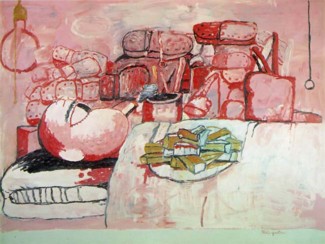The climactic gallery of the Royal Academy’s Philip Guston retrospective contains some of the most vital, vivid and raucous pictures created by any American artist during the course of the twentieth century. “Laughing in the dark” was how the painter once curtly described what he was up to, in the work of his later years. The mood that emanates from these powerful, battered-looking paintings, with their emphatically weird and cartoon-like images rendered on a monumental scale, is a fierce hilarity, a manic, black humour, tinged by melancholia and an inescapable sense of the absurd. The experience of walking into this room is simultaneously exhilarating and unsettling, almost like encountering some wonderful but previously unknown cycle of frescoes – Giotto and Piero della Francesca were among Guston’s greatest heroes – on a theme which continues to resist precise identification.
Guston was a contemporary (and school-fellow) of Jackson Pollock who, by the standards of most New York School painters, lived his life back-to-front. Mired in self-doubt and paralysed by anxiety for much of his early career, he suddenly discovered an access of energy and iconoclastic self-confidence as he entered old age. He died in 1980 at the age of 67, having invented a whole world during the last ten years of his life. The dramatis personae who throng this place – Gustonland – are pathetic and generally abbreviated figures, resembling vestiges or dregs of humanity. Piles of scrawny, hairy legs, wearing hobnailed boots, accumulate mysteriously on distant shores under darkening skies. Disembodied heads cluster in a lurid, cadmium-red wasteland, the expressions on their distorted, comic-book faces suggestive of mute despair and resignation. An outrageously foolish-looking dog gorges itself on trash while wars are fought out between massed ranks of luridly veined forearms and raw-knuckled fists, brandishing dustbin lids instead of shields. Accompanying...

Philip Guston at the Royal Academy 2004
25-01-2004

